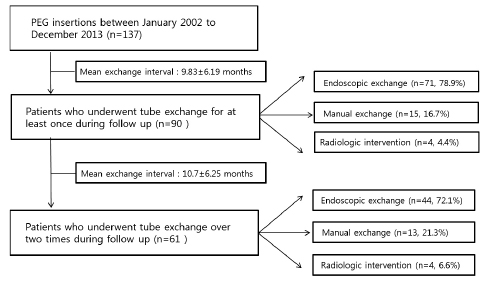Korean J Gastroenterol.
2018 Jan;71(1):24-30. 10.4166/kjg.2018.71.1.24.
Clinical Course of Percutaneous Endoscopic Gastrostomy: A Single-center Observational Study
- Affiliations
-
- 1Department of Internal Medicine and Ewha Medical Research Institute, Ewha Womans University College of Medicine, Seoul, Korea. shimkn@ewha.ac.kr
- KMID: 2402802
- DOI: http://doi.org/10.4166/kjg.2018.71.1.24
Abstract
- BACKGROUND/AIMS
Percutaneous endoscopic gastrostomy (PEG) is a widely used method for long-term tube feeding. This study aimed to investigate the clinical characteristics and outcomes of patients who utilized long-term feeding tube via PEG.
METHODS
The medical records of 137 patients who underwent PEG tube insertion at Ewha Womans University Mokdong Hospital between January 2002 and December 2013 were reviewed.
RESULTS
PEG was indicated most frequently for cerebrovascular accidents (66 patients, 48.2%), followed by head and neck cancer (20 patients, 14.6%), and Parkinson's disease (10 patients, 7.3%). The tubes were endoscopically inserted in 133 patients (97.1%); 4 patients (2.9%) underwent radiologic intervention. The tubes of 90 patients (65.7%) were exchanged at least once during the follow-up period. At the first exchange, 71 patients (78.9%) had their tubes exchanged by endoscopy, 24 patients (16.7%) by manually, and 4 patients (4.4%) by radiologic intervention. Of the 61 patients (44.5%) who had their tubes exchanged twice, 44 patients (72.1%) changed their tubes by endoscopic exchange, 13 patients (21.3%) by manually, and 4 patients (4.4%) via radiologic intervention. The mean time interval between the initial insertion and the first exchange was 9.83±6.19 months, and that between the initial insertion and the second exchange was 10.7±6.25 months. Of all the 137 patients, acute complications at initial insertion occurred in only 18 patients (13.1%), with insertion site infection (9 patients, 6.6%) being the most common acute complication.
CONCLUSIONS
PEG appears to be a safe procedure for providing long-term tube feeding. Our results may help to develop strategies for further management of subjects receiving feeding tubes via PEG.
Keyword
MeSH Terms
Figure
Reference
-
1. Nicholson FB, Korman MG, Richardson MA. Percutaneous endoscopic gastrostomy: a review of indications, complications and outcome. J Gastroenterol Hepatol. 2000; 15:21–25.
Article2. Gauderer MW, Ponsky JL, Izant RJ Jr. Gastrostomy without laparotomy: a percutaneous endoscopic technique. J Pediatr Surg. 1980; 15:872–875.
Article3. Mendiratta P, Tilford JM, Prodhan P, Curseen K, Azhar G, Wei JY. Trends in percutaneous endoscopic gastrostomy placement in the elderly from 1993 to 2003. Am J Alzheimers Dis Other Demen. 2012; 27:609–613.
Article4. Grant JP. Comparison of percutaneous endoscopic gastrostomy with Stamm gastrostomy. Ann Surg. 1988; 207:598–603.5. Bankhead RR, Fisher CA, Rolandelli RH. Gastrostomy tube placement outcomes: comparison of surgical, endoscopic and laparoscopic methods. Nutr Clin Pract. 2005; 20:607–612.
Article6. Oh DJ, Kim B, Lee JK, et al. Can percutaneous endoscopic gastrostomy be carried out safely in the elderly? Geriatr Gerontol Int. 2016; 16:481–485.
Article7. McClave SA, Ritchie CS. The role of endoscopically placed feeding or decompression tubes. Gastroenterol Clin North Am. 2006; 35:83–100.
Article8. Schrag SP, Sharma R, Jaik NP, et al. Complications related to percutaneous endoscopic gastrostomy (PEG) tubes. A comprehensive clinical review. J Gastrointestin Liver Dis. 2007; 16:407–418.9. Vanis N, Saray A, Gornjakovic S, Mesihovic R. Percutaneous endoscopic gastrostomy (PEG): retrospective analysis of a 7-year clinical experience. Acta Inform Med. 2012; 20:235–237.
Article10. Kusano C, Yamada N, Kikuchi K, Hashimoto M, Gotoda T. Current status of percutaneous endoscopic gastrostomy (PEG) in a general hospital in Japan: a cross-sectional study. J Rural Med. 2016; 11:7–10.
Article11. Gundogan K, Yurci A, Coskun R, et al. Outcomes of percutaneous endoscopic gastrostomy in hospitalized patients at a tertiary care hospital in Turkey. Eur J Clin Nutr. 2014; 68:437–440.12. Finocchiaro C, Galletti R, Rovera G, et al. Percutaneous endoscopic gastrostomy: a long term follow-up. Nutrition. 1997; 13:520–523.13. Zopf Y, Konturek P, Nuernberger A, et al. Local infection after placement of percutaneous endoscopic gastrostomy tubes: a prospective study evaluation risk factors. Can J Gastroenterol. 2008; 22:987–991.14. Akkersdijk WL, van Bergeijk JD, van Egmond T, et al. Percutaneous endoscopic gastrostomy (PEG): comparsion of push and pull methods and evaluation of antibiotic prophylaxis. Endoscopy. 1995; 27:313–316.15. Gossner L, Keymling J, Hahn EG, Ell C. Antibiotic prophylaxis in percutaneous endoscopic gastrostomy (PEG): a prospective randomized clinical trial. Endoscopy. 1999; 31:119–124.
Article16. Sobani ZA, Tin K, Guttmann S, Abbasi AA, Mayer I, Tsirlin Y. Safety of percutaneous endoscopic gastrostomy tubes in centenarian patients. Clin Endosc. 2017; 07. 21. [Epub ahead of print].
Article17. Lee CG, Kang HW, Lim YJ, et al. Comparison of complications between endoscopic and percutaneous replacement of percutaneous endoscopic gastrostomy tubes. J Korean Med Sci. 2013; 28:1781–1787.
Article18. Bruckstein AH. Managing the percutaneous endoscopic gastrostomy tube. Postgrad Med. 1987; 82:143–146.
Article
- Full Text Links
- Actions
-
Cited
- CITED
-
- Close
- Share
- Similar articles
-
- Long Term Efficacy of Percutaneous Endoscopic Gastrostomy
- Percutaneous Endoscopic Gastrostomy Through the Sinus Tract of a Surgical Gastrostomy
- A Case of Percutaneous Endoscopic Gastrostomy in a Patient with Liver Cirrhosis Accompanied by Both Esophageal and Gastric Varices
- A Case of Buried Bumper Syndrome; A case report
- Acute Shunt Malfunction Caused by Percutaneous Endoscopic Gastrostomy without Shunt Infection


